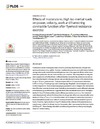Please use this identifier to cite or link to this item:
https://accedacris.ulpgc.es/jspui/handle/10553/69297
| DC Field | Value | Language |
|---|---|---|
| dc.contributor.author | Piqueras-Sanchiz, Francisco | en_US |
| dc.contributor.author | Martín Rodríguez, Saúl | en_US |
| dc.contributor.author | Manuel Martinez-Aranda, Luis | en_US |
| dc.contributor.author | Lopes, Thiago Ribeiro | en_US |
| dc.contributor.author | Raya-Gonzalez, Javier | en_US |
| dc.contributor.author | Garcia-Garcia, Oscar | en_US |
| dc.contributor.author | Nakamura, Fabio Yuzo | en_US |
| dc.date.accessioned | 2020-01-23T14:14:48Z | - |
| dc.date.available | 2020-01-23T14:14:48Z | - |
| dc.date.issued | 2019 | en_US |
| dc.identifier.issn | 1932-6203 | en_US |
| dc.identifier.other | WoS | - |
| dc.identifier.uri | https://accedacris.ulpgc.es/handle/10553/69297 | - |
| dc.description.abstract | Flywheel iso-inertial training has been shown to positively affect muscular strength and sports performance (e. g. agility). However, implementing such eccentrically-biased training during a microcycle needs to be carefully planned due to its purported effects on the neuromuscular system that can last for hours/days post-exercise. This study aimed at using tensiomyography to verify the effects of different inertias during the hip extension exercise on the contractile function of biceps femoris and semitendinosus muscles of the dominant leg for up to 72 hours post-exercise. Thirty participants (24.4 +/- 3.4 years) were divided into 0.075 or 0.1 kg.m(2) inertia groups and a control group. Magnitude-based analysis was used for the comparisons. Several tensiomyography parameters were changed after both intensities of flywheel exercise (in most cases indicating a decrement in muscle stiffness), whereas most between-group differences suggested that in the semitendinosus muscle, the higher inertia (0.1 kg.m(2)) influenced the muscle stiffness parameters more (e.g. Dm = maximal radial displacement) while in the biceps femoris, the greater effect was caused by the lower inertia (0.075 kg.m(2)) (e.g. Tc = contraction time). Most changes in contractile properties of the investigated muscles occur within 24 hours post-exercise, but can persist for up to 72 hours. However, higher inertia (0.1 kg.m(2)) influenced the stiffness of the semitendinosus muscle more, while in the biceps femoris, the greater effect was caused by the lower inertia (0.075 kg.m(2)). These findings should be considered by practitioners when prescribing flywheel iso-inertial training. | en_US |
| dc.language | eng | en_US |
| dc.relation.ispartof | PLoS ONE | en_US |
| dc.source | Plos One[ISSN 1932-6203],v. 14 (2) | en_US |
| dc.subject | 3313 Tecnología e ingeniería mecánicas | en_US |
| dc.subject.other | Human Skeletal-Muscle | en_US |
| dc.subject.other | Eccentric-Overload | en_US |
| dc.subject.other | Measurement Error | en_US |
| dc.subject.other | Neural-Control | en_US |
| dc.subject.other | Leg Stiffness | en_US |
| dc.subject.other | Strength | en_US |
| dc.subject.other | Reliability | en_US |
| dc.subject.other | Performance | en_US |
| dc.subject.other | Adaptations | en_US |
| dc.subject.other | Responses | en_US |
| dc.title | Effects of moderate vs. high iso-inertial loads on power, velocity, work and hamstring contractile function after flywheel resistance exercise | en_US |
| dc.type | info:eu-repo/semantics/Article | en_US |
| dc.type | Article | en_US |
| dc.identifier.doi | 10.1371/journal.pone.0211700 | |
| dc.identifier.scopus | 85061211686 | |
| dc.identifier.isi | 000458026000048 | - |
| dc.contributor.authorscopusid | 57194395450 | |
| dc.contributor.authorscopusid | 56335855800 | |
| dc.contributor.authorscopusid | 57196320336 | |
| dc.contributor.authorscopusid | 57189329454 | |
| dc.contributor.authorscopusid | 56335780600 | |
| dc.contributor.authorscopusid | 55315989200 | |
| dc.contributor.authorscopusid | 8880204300 | |
| dc.identifier.issue | 2 | - |
| dc.relation.volume | 14 | - |
| dc.investigacion | Ingeniería y Arquitectura | en_US |
| dc.type2 | Artículo | en_US |
| dc.contributor.daisngid | 11373223 | |
| dc.contributor.daisngid | 6383644 | |
| dc.contributor.daisngid | 16602699 | |
| dc.contributor.daisngid | 4725226 | |
| dc.contributor.daisngid | 2413380 | |
| dc.contributor.daisngid | 3748934 | |
| dc.contributor.daisngid | 162067 | |
| dc.utils.revision | Sí | en_US |
| dc.contributor.wosstandard | WOS:Piqueras-Sanchiz, F | |
| dc.contributor.wosstandard | WOS:Martin-Rodriguez, S | |
| dc.contributor.wosstandard | WOS:Martinez-Aranda, LM | |
| dc.contributor.wosstandard | WOS:Lopes, TR | |
| dc.contributor.wosstandard | WOS:Raya-Gonzalez, J | |
| dc.contributor.wosstandard | WOS:Garcia-Garcia, O | |
| dc.contributor.wosstandard | WOS:Nakamura, FY | |
| dc.date.coverdate | Febrero 2019 | |
| dc.identifier.ulpgc | Sí | es |
| dc.description.sjr | 1,1 | |
| dc.description.jcr | 2,776 | |
| dc.description.sjrq | Q1 | |
| dc.description.jcrq | Q2 | |
| dc.description.scie | SCIE | |
| dc.description.erihplus | ERIH PLUS | |
| item.grantfulltext | open | - |
| item.fulltext | Con texto completo | - |
| crisitem.author.orcid | 0000-0003-2423-5309 | - |
| crisitem.author.fullName | Martín Rodríguez, Saúl | - |
| Appears in Collections: | Artículos | |
Show simple item record
SCOPUSTM
Citations
22
checked on Jun 8, 2025
WEB OF SCIENCETM
Citations
20
checked on Jun 8, 2025
Page view(s)
140
checked on May 31, 2025
Download(s)
219
checked on May 31, 2025
Google ScholarTM
Check
Altmetric
Share
Export metadata
Items in accedaCRIS are protected by copyright, with all rights reserved, unless otherwise indicated.
